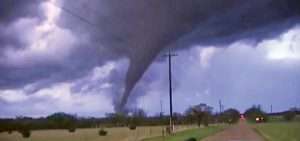Frank J. Buchman
Columnist
Kansas is one of the most tornado-prone states in the country.
The state averages 92 tornadoes annually, according to Victor Gensini representing the National Oceanic Atmospheric Administration.
There were 63 tornadoes in Kansas during 2022, Gensini said.
And 2023 is already shaping up to have higher-than-average tornadoes, he added.
Tornado season in Kansas typically runs April through June each year. In early spring, warm humid air from the Gulf of Mexico mixes with cool dry air from the North and warm dry air from the West, which combine to form tornadic conditions.
While Kansas can experience a twister outside of April, May, and June, residents should be well prepared for disaster to strike during these months.
With 112 tornadoes from 1950 to 2022, Ford County in western Kansas has experienced more twisters than any other county in Kansas. Sherman County has had 105, and Barton County had 103.
From 1997 to 2022, Kansas had an annual average of 86 tornadoes per year.
The month of May sees the most tornadoes in Kansas, followed by June, then April. November, December, January, and February see the least number of tornadoes.
Homeowners insurance in Kansas covers damage caused by tornadoes, including the wind, hail, and rain that accompany them.
However, water damage from flooding that occurs during a tornado would not be covered under the standard home insurance policy. Some Kansas homeowners have a separate windstorm deductible for tornado damage.
If a home is damaged in a tornado, the home insurance company may require payment of windstorm deductible. That’s separate from the standard homeowner’s insurance deductible and applies specifically to wind and hail damage.
Windstorm deductibles in Kansas are typically a percentage of a policy’s dwelling coverage limit, usually between 1-percent and 5-percent, according to the Insurance Information Institute. A higher deductible leads to lower insurance rates, and vice versa.
Advice has been given to prepare for the tornado season in Kansas.
Get the home ready for severe weather. This includes trimming tree limbs, removing dead trees, cleaning up heavy debris, and moving lawn furniture inside.
Make an emergency kit. Include water, non-perishable foods, can opener, towelettes, trash bags, batteries, flashlights, first aid kit, portable cell phone chargers, battery-powered radio, and whistle to signal for help.
Find a place to take shelter. While no place will be completely safe during a tornado, hunkering down in a basement or inside a windowless room on the lowest floor of the home is the safest bet. For even more protection, take shelter under something sturdy like a heavy table or workbench, cover with a blanket or mattress, and protect the head from flying debris.
Know the signs of a tornado. Be on the lookout for rotating, funnel-shaped clouds, low-lying clouds of debris, large hail, a dark or green-colored sky, and a loud roar that sounds like a freight train.
Sign up for severe weather alerts from the National Weather Service via text, email, or phone. In addition, many cities throughout Kansas have outdoor warning siren systems to warn residents to take shelter indoors during extreme weather conditions, including tornadoes.
Stay up to date on changing weather conditions via local news and radio stations or even through social media.
True tornado preparedness requires a plan. At home, make a family emergency plan and have a conversation with loved ones about the importance of being prepared.
At work, contact the Human Resources department to learn the safety procedures for tornados and other disasters. Or use guidelines from the Occupational Safety and Health Administration (OSHA) to create a tornado response plan for the business.
Practice the disaster response plans at least twice a year at home and at work. Regular drills help everyone learn the safety procedures for tornadoes, and they let you test and tweak your plan so you can be better prepared in a real emergency.
Preparedness can help keep the family safe if a tornado hits, but it may not be able to protect property against the strength of these devastating storms.





